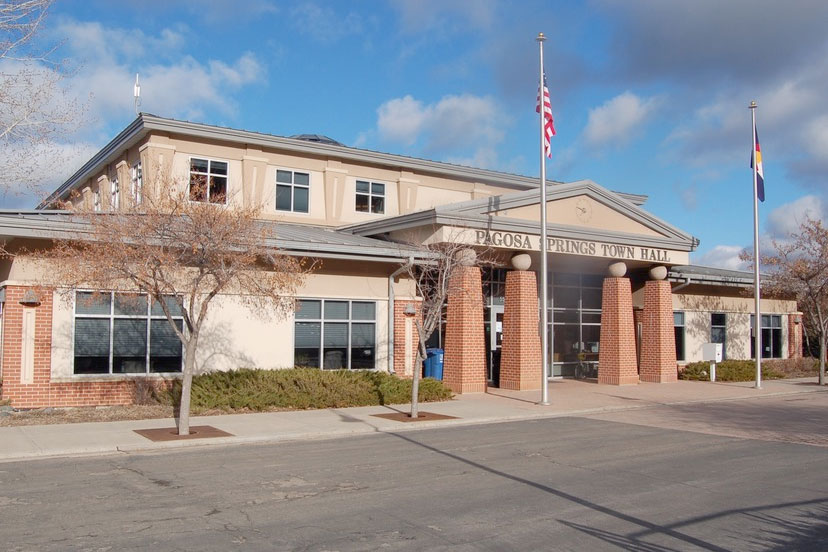Photo: Pagosa Springs Town Hall.
We shared a well-written opinion piece yesterday, by Daily Post columnist Hank Lydick, addressing a controversy at the Pagosa Area Water and Sanitation District — the special district that provides drinking water to most of the core subdivisions in Archuleta County, and some of the outlying subdivisions. One of those outlying subdivisions is Elk Park.
As Mr. Lydick points out, our governments have made agreements, in the past, to provide certain services to the citizens and taxpayers, and there’s an understandable expectation that those services will continue to be provided. The cost of providing those services may change, however. And I suppose we have a certain expectation that, as the cost of everything gets inflated, the cost of government will do the same.
The alternative to the higher cost of government would seem to be, “fewer services”.
The natural tendency of most any organization, however, is to try and grow larger, and offer more. Is this what the Pagosa Springs taxpayers and voters want? More services, at an ever higher cost?
When the Archuleta Board of County Commissioners put Measure 1A on the November 2022 ballot, they promised better road maintenance and the expansion of other services in exchange for a 37% increase in the County sales tax. The Town Council supported this ballot measure, as did the Pagosa Springs Community Development Corporation.
But the voters overwhelmingly rejected the proposal.
Two earlier attempts by the County to increase the sales tax for a new jail were also defeated.
When the San Juan Water Conservancy District asked for a modest mill levy increase in 2018, to fund further work on a proposed water reservoir in the Dry Gulch valley, the voters said ‘No’ by a 3-to-1 margin.
Recent tax increase proposals by the Pagosa Fire Protection District and the Archuleta School District, by comparison, were overwhelmingly approved by local voters. Tax increases requested by the publicly-owned Pagosa Springs Medical Center have also solicited popular approval.
How do we explain voter support for some tax increases, and not for others? I have my assumptions, but they are only that: assumptions. It’s common practice to survey the voters prior to an election, but almost never does a government try to find out why their tax measure failed. The explanation offered by government leaders following a defeat is typically, “The voters didn’t understand. There was too much misinformation.”
Sometimes, a local government district doesn’t need to ask for more funding. The Town of Pagosa Springs, for example, has managed to constantly expand its impact and services without asking for increased taxes. (Its fees, however, have increased on a regular basis.) As far as I can tell, almost all of the expansion of the Town government over the past couple of decades has been in the area of tourist services and recreation, paid for by a mix of local sales and lodging taxes and grant funding.
The Town of Pagosa Springs has a curiously privileged financial position in our community. In the 1990s, the Town annexed nearly all of the commercially viable properties west and east of downtown, which theoretically gave the Town access to nearly all of the community’s sales tax revenues. But the Town generously agreed to share the sales tax 50/50 with the County government.
From the Town’s 2024 Budget document:
For about a decade, the Town has enjoyed consistent year-over-year increases in the growth of sales
tax. A decade ago, the total sales tax for the Town was $4.1 million. For 2024, total sales tax is projected to
be about $8.8 million, or more than double. While a decade is a significant time period, it only illustrates the point that things are now different for the Town.
We can’t help but point out that the population of the Town is about 1,770. So the sales tax revenues amount to about $4,970 per person.
The other half of the 2024 sales tax revenues will accrue to the County government. So, about $8.8 million. Give or take. Archuleta County has a population of about 14,400. That comes to about $610 in sales tax revenue, per person.
Which is to say, the Town government receives eight times as much sales tax revenue per person, as the County does. This is not the whole picture of how the Town and County are funded, but it’s a big part of the picture.
You could also compare the sales tax by area served. The Town is responsible for maintaining about 3,200 acres of infrastructure and services. That comes to about $2,750 per acre in 2024.
The Archuleta County government is responsible for serving about 31% of the county, about 271,000 acres. (The rest is under the authority of the National Forest Service or the Southern Ute tribe.) So the County’s sales tax revenues amount to about $32 per acre.
Which is to say, the Town’s sales tax revenues, per acre are about 86 times the County’s revenues.
Again, this isn’t the entire revenue picture for the two governments. But it helps explain why the Town Council seems fast and loose with their spending decisions, even compared to the BOCC. And maybe also, why the BOCC is much deeper in debt than the Town government.
In my experience, two of the seven Town Council members — Mayor Shari Pierce and Council member Leonard Martinez — are the most careful with the Town’s revenues, and tend to vote ‘No’ on what some of us might consider ‘frivolous spending’ proposals. They tend to be the fiscal conservatives on the Council, in other words.
Next week, in Part Two, I will go a little deeper into what I mean by ‘frivolous spending’ by the Town Council.
It’s what naturally happens when a government has ‘too much money’, I suppose.

